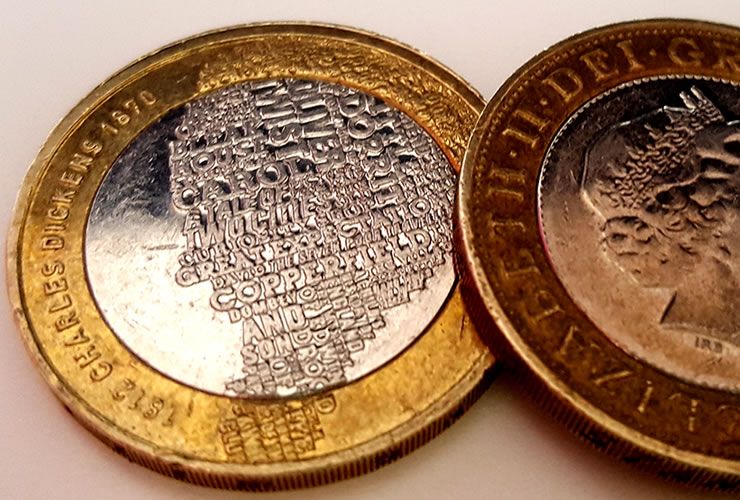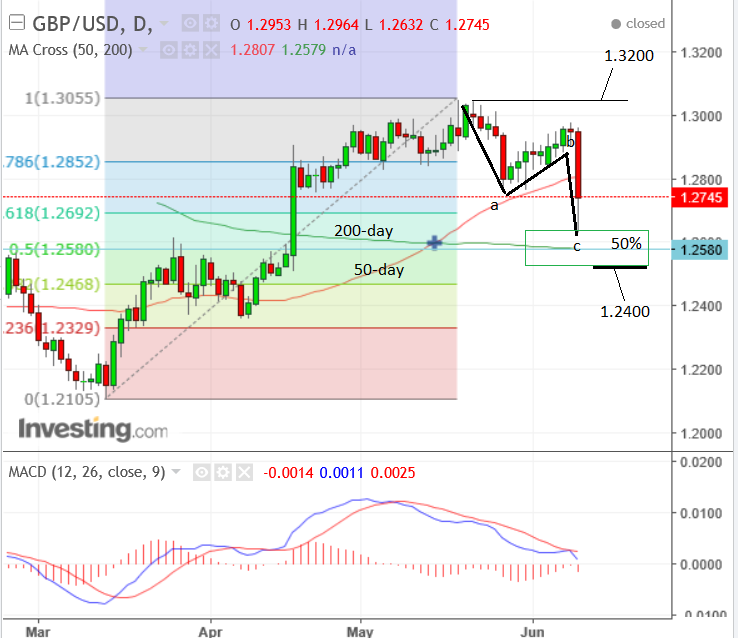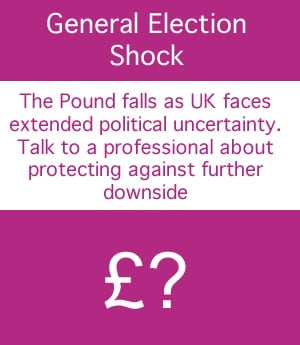5-Day Forecast for GBP/USD Rate Forecast Suggests Potential for Gains

The GBP/USD exchange rate sold off heavily following the election result, tumbling to lows of 1.2637 before recovering to end the week at 1.2745.
Overall the exchange rate has substantially corrected the rally up from 1.20 to 1.30 in March.
The form of the correction, including the election sell-off, describes a classic corrective a-b-c pattern from the May highs (see below).
This means that the uptrend remains intact as the sell-off is still probably only a correction rather than a reversal.
This seems to back-up warnings of a ‘bear trap’.
The relationship between the election result and Brexit is highly nuanced and although the Pound sold off initially, this may just be a knee-jerk reaction to the failure of the government to win a clear majority.
If circumstances emerge which favour a softer Brexit – a stronger possibility than before then the Pound could recover rapidly.
Looking at the charts we see that to confirm a bearish continuation the exchange rate would first have to break below the 1.2637 lows, as this would reverse the sequence of peaks and troughs from up to down.

A break back below 1.2637, however, would probably only lead to limited follow-through lower due to the strong support zone in the 1.2580 region.
This is composed of the 50% Fibonacci level of the previous rally and the 200-day moving average are situated.
The 50% level is the halfway point in the previous up move (from March to May). Research has shown this to be a significant support level where prices often stall, consolidate or even reverse trend completely.
Moving averages, like the 200-day, are dynamic levels of support and resistance where prices often coalesce, stall and move going sideways, or sometimes even reverse trend completely.
Given these levels of support we would remain bearish but cautiously so after a break below 1.2637.
For stronger confirmation of a bearish continuation we would ideally wish to see a break below the 50% Fibonacci level and the 200-day.
This would be confirmed by a move below 1.2530, which would then be likely to fall to a target at 1.2400.
If 1.2637 holds then the uptrend will technically remain intact and the pair would be expected to break above the 1.3051 highs to a target at 1.3200 eventually.
 Analyst Robin Wilkin at Lloyds Bank meanwhile eyes important resistance at 1.2850.
Analyst Robin Wilkin at Lloyds Bank meanwhile eyes important resistance at 1.2850.
"A rally through these levels is needed to suggest the market can re-test the 1.3050-1.3100 resistance region. Until then our medium-term bias remains for a move back towards supports around 1.2550, with 1.2350 below there, within a 1.1980–1.3100 range," says Wilkin.
Long-term, Lloyds believe 1.0350 completed the cycle from the 2008 highs at 1.6020.
"So, eventually, we look for a move back to 1.20-1.23 and then ultimately back to 1.30-1.31. However, for now we see a broader range under 1.1350-1.1450 first," says Wilkin.
Data for the Dollar
Inflation (CPI), including ‘factory gate’ Inflation (PPI), and Retail Sales, dominate the first half of the week, followed by the Federal Reserve Open Market Committee (FOMC) meeting on Wednesday evening, June 14, at 19.00, at which Fed members will set the level of base US interest rates.
The hard data at the start of the week is likely to disappoint, according to analyst Kathy Lien of BK Asset Management, pulling down the Dollar in the first few days, whilst the FOMC will almost certainly raise US interest rates by 0.25% leading to an uplift, thus describing a roughly U-shaped forecast for the Dollar in the week ahead.
Inflation is out at 13.30 on Wednesday, with a small 0.1% rise expected for headline CPI in May from the previous month and a 0.2% rise for Core.
Factory Gate Prices are out on Tuesday at 13.30 and expected to show a market slowdown of only 0.1% in May from 0.5% in April.
Retail Sales are out at 13.30 on Wednesday and likewise forecast to only show a 0.1% rise from 0.4% in the previous month.
Data, Events to Watch for the Pound
Pound Sterling Live will be covering the political landscape and its impact on Sterling.
We see the prospect of a stronger Pound should the election outcome point to a softer-Brexit.
"The UK election outcome raises a potential for an alternative to the hard Brexit which was what PM May was seemingly pushing for," says Viraj Patel at ING Bank N.V. "The loss of the Conservative seats has exposed vulnerability to the strategy PM May was pursuing and leaves her very vulnerable within her party. She now needs to accept a broader range of views within the party to secure a leadership."
In terms of hard Brexit, which GBP crosses seems to be pricing in, it would be difficult to push it through the UK Parliament given the fragile Conservative-DUP confidence-and-supply deal.
"Hence, we see more room for re-pricing," says Patel.
ING are now actually willing to bet on a rise in the value of the Pound and "prefer to go long GBP against USD given our constructive EUR/USD view."
But, keep one eye on data for surprises.
A busy week for the Pound kicks off with May inflation data at 09.30 BST on Tuesday, which is expected to show a slower 0.2% rise compared to the 0.5% rise in April.
Employment data is out at 9.30 on Wednesday, June 14, and although the unemployment rate is forecast to remain at a very low 4.6%, it is the average earnings statistic which will be the centre of attention given economists concerns about falling real earnings impacting on consumer spending.
The May retail sales release is out on Thursday Morning a 9.30, and is forecast to show a dramatic slow-down, and even a -0.8% contraction compared to the previous month rise of 2.3%.
The Bank of England (BOE) rate meeting is on Thursday at 12.00 but no change in policy or voting is expected, and arch-hawk Forbes will not be present.




